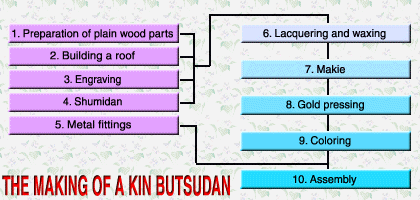|
1.
Preparation of plain wood parts
The important parts outside and inside the altar are built
by mortise joints, for the sake of precision and the ease with which the
altar can be disassembled and reassembled.
2.
Building a roof
The roof of an altar is made by the method established in the latter half
of the 17th century - a method by which roof boards are mounted on the
crossbeam to give the altar a gorgeous look.
3.
Engraving
The altar is engraved with various designs created in the long
history of our tradition. Various techniques - such as "Kago-bori" for
engraving a single board, "Kaki-bori", "Tsuke-gata" and "Kasane-gata"
- are used to give the altar three-dimensional look and artistic expressions.
4.
Shumidan
Shumidan (a dais for a Buddhist image) is to represent the
holly mountain Shumi (a towering mountain at the center of the universe),
and it is the essential part of the Buddhist altar where the Buddha is
placed. An exquisite combination of straight lines and curves is required.
5.
Metal fittings
Copper sulfate and green copper rust are used to give a unique
coloring and tint to the metal fittings. They are excellent in their workmanship
as traditional crafts.
6.
Lacquering and waxing
There are two methods of lacquering - Tate-nuri and roiro-nuri.
The latter consists of several processes, including preparations of wooden
parts, undercoating, second coating, final coating and polishing by powder
of antlers. This will give a deep and exquisite luster to the altar.
7.
Makie
Depending on what part of butsudan it is, different methods
of makie (gold lacquering) are applied - "Taka-makie (raised gold lacquering)",
"Hira-makie (flat gold lacquering)" and "Hakushita-makie (gold lacquering
under leaves)".
8.
Gold pressing
Traditionally there are three methods of gold pressing - "Hikari-oshi",
"Tsuyakeshi-oshi" and "Nugui", which are jointly applied in practice.
Among others, "Tsuyakeshi-oshi (subdued gold pressing)" calls for a high
level of technique.
9.
Coloring
"Sumitori" coloring method is applied to the columns, ceiling
and transoms, and "Kashoku" method to the wooden parts such as figures,
flowers and birds. No mistake is allowed since rich colors are directly
applied using sharp brushes.
10.
Assembly
This is the final process - a process of assembling many parts
carefully, precisely and firmly, which have been made by many experts.
|


